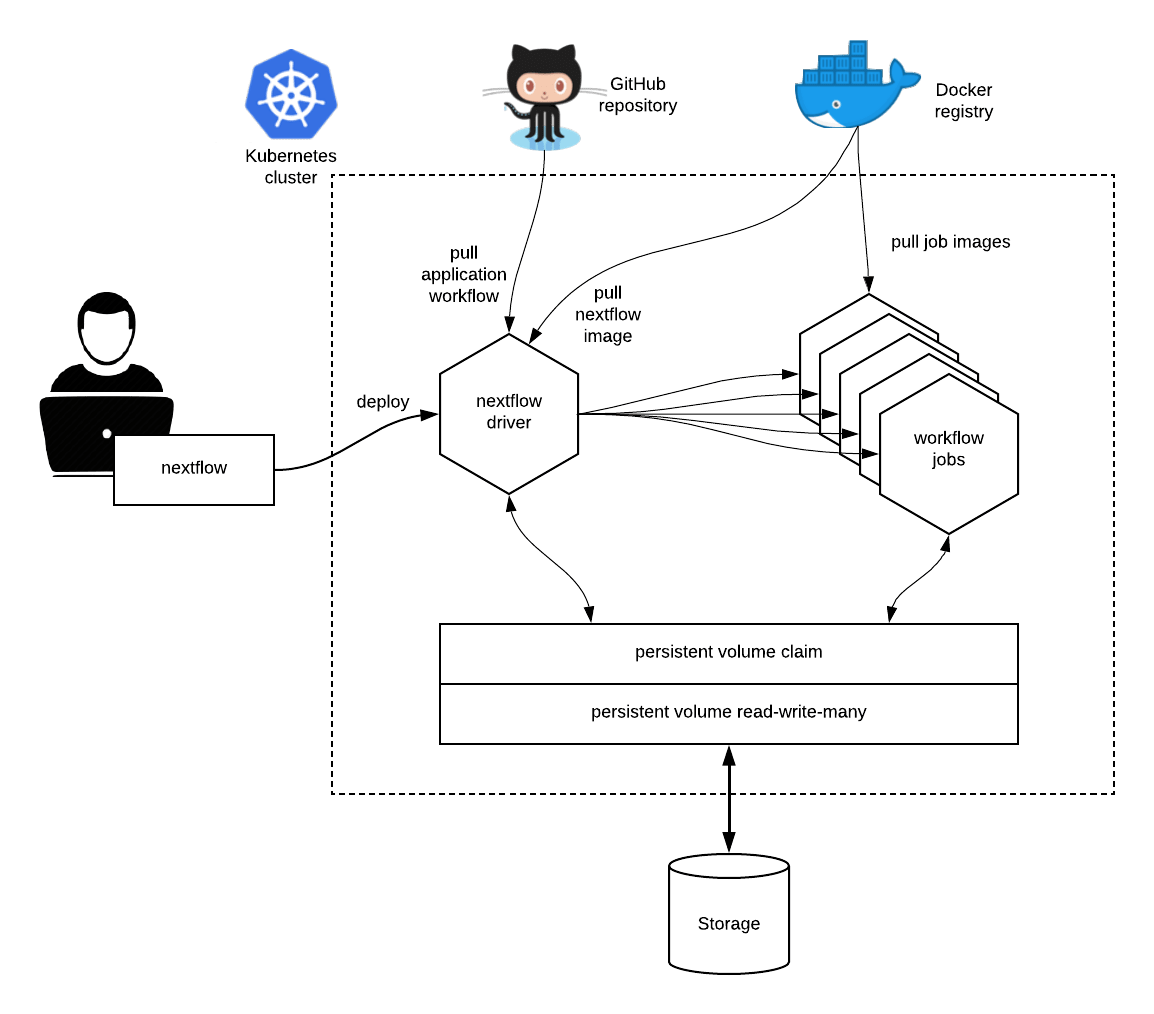Kubernetes¶
Kubernetes is a cloud-native open-source system for deployment, scaling, and management of containerized applications.
It provides clustering and file system abstractions that allows the execution of containerised workloads across different cloud platforms and on-premises installations.
The built-in support for Kubernetes provided by Nextflow streamlines the execution of containerised workflows in Kubernetes clusters.
Warning
This is an experimental feature and it may change in a future release. It requires Nextflow version 0.28.0 or higher.
Concepts¶
Kubernetes main abstraction is the pod. A pod defines the (desired) state of one or more containers i.e. required computing resources, storage, network configuration.
Kubernetes abstracts also the storage provisioning through the definition of one more more persistent volumes that allow containers to access to the underlying storage systems in a transparent and portable manner.
When using the k8s executor Nextflow deploys the workflow execution as a Kubernetes pod. This pod orchestrates
the workflow execution and submits a separate pod execution for each job that need to be carried out by the workflow
application.

Requirements¶
At least a Persistent Volume with
ReadWriteMany access mode has to be defined in the Kubernetes cluster (check the supported storage systems
at this link).
Such volume needs to be accessible through a Persistent Volume Claim, which will be used by Nextflow to run the application and store the scratch data and the pipeline final result.
The workflow application has to be containerised using the usual Nextflow container directive.
Execution¶
The workflow execution needs to be submitted from a computer able to connect to the Kubernetes cluster.
Nextflow uses the Kubernetes configuration file available at the path $HOME/.kube/config or the file specified
by the environment variable KUBECONFIG.
You can verify such configuration with the command below:
$ kubectl cluster-info
Kubernetes master is running at https://your-host:6443
KubeDNS is running at https://your-host:6443/api/v1/namespaces/kube-system/services/kube-dns:dns/proxy
To deploy and launch the workflow execution use the Nextflow command kuberun as shown below:
nextflow kuberun <pipeline-name> -v vol-claim:/mount/path
This command will create and execute a pod running the nextflow orchestrator for the specified workflow.
In the above example replace <pipeline-name> with an existing nextflow project or the absolute path
of a workflow already deployed in the Kubernetes cluster.
The -v command line option is required to specify the volume claim name and mount path to use for the workflow
execution. In the above example replace vol-claim with the name of an existing persistent volume claim and
/mount/path with the path where the volume is required to be mount in the container. Volume claims can also be
specified in the Nextflow configuration file, see the Kubernetes configuration section for details.
Once the pod execution starts, the application in the foreground prints the console output produced by the running workflow pod.
Interactive login¶
For debugging purpose it’s possible to execute a Nextflow pod and launch an interactive shell using the following command:
nextflow kuberun login -v vol-claim:/mount/path
This command creates a pod, sets up the volume claim(s), configures the Nextflow environment and finally launches a Bash login session.
Warning
The pod is automatically destroyed once the shell session terminates. Do not use to start long running workflow executions in background.
Running in a pod¶
The main convenience of the kuberun command is that it spares the user from manually creating a pod from
where the main Nextflow application is launched. In this scenario, the user environment is not containerised.
However there are scenarios in which Nextflow needs to be executed directly from a pod running in a
Kubernetes cluster. In these cases you will need to use the plain Nextflow run command and specify
the k8s executor and the required persistent volume claim in the nextflow.config file as shown below:
process {
executor = 'k8s'
}
k8s {
storageClaimName = 'vol-claim'
storageMountPath = '/mount/path'
}
In the above snippet replace vol-claim with the name of an existing persistent volume claim and replace
/mount/path with the actual desired mount path eg. /workspace.
Warning
The running pod must have been created with the same persistent volume claim name and mount as the
one specified in your Nextflow configuration file.
Note also that the run command does not support the -v option.
Pod settings¶
The process pod directive allows the definition of pods specific settings, such as environment variables, secrets and config maps when using the Kubernetes executor. See the pod directive for more details.
Limitation¶
Currently, the kuberun command does not allow the execution of local Nextflow scripts.
Advanced configuration¶
Read Kubernetes configuration and executor sections to learn more about advanced configuration options.